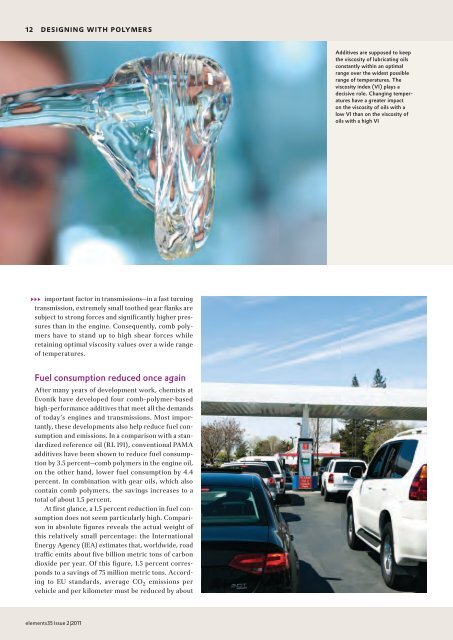Download - Evonik Industries
Download - Evonik Industries
Download - Evonik Industries
You also want an ePaper? Increase the reach of your titles
YUMPU automatically turns print PDFs into web optimized ePapers that Google loves.
12 DesIGnInG WItH PoLYMeRs<br />
333 important factor in transmissions—in a fast turning<br />
transmission, extremely small toothed gear flanks are<br />
subject to strong forces and significantly higher pressures<br />
than in the engine. Consequently, comb polymers<br />
have to stand up to high shear forces while<br />
retaining optimal viscosity values over a wide range<br />
of temperatures.<br />
Fuel consumption reduced once again<br />
After many years of development work, chemists at<br />
<strong>Evonik</strong> have developed four comb-polymer-based<br />
high-performance additives that meet all the demands<br />
of today’s engines and transmissions. Most importantly,<br />
these developments also help reduce fuel consumption<br />
and emissions. In a comparison with a standardized<br />
reference oil (RL 191), conventional PAMA<br />
additives have been shown to reduce fuel consumption<br />
by 3.5 percent—comb polymers in the engine oil,<br />
on the other hand, lower fuel consumption by 4.4<br />
percent. In combination with gear oils, which also<br />
contain comb polymers, the savings increases to a<br />
total of about 1.5 percent.<br />
At first glance, a 1.5 percent reduction in fuel consumption<br />
does not seem particularly high. Comparison<br />
in absolute figures reveals the actual weight of<br />
this relatively small percentage: the International<br />
Energy Agency (IEA) estimates that, worldwide, road<br />
traffic emits about five billion metric tons of carbon<br />
dioxide per year. Of this figure, 1.5 percent corresponds<br />
to a savings of 75 million metric tons. According<br />
to EU standards, average CO 2 emissions per<br />
vehicle and per kilometer must be reduced by about<br />
elements35 Issue 2|2011<br />
Additives are supposed to keep<br />
the viscosity of lubricating oils<br />
constantly within an optimal<br />
range over the widest possible<br />
range of temperatures. The<br />
viscosity index (VI) plays a<br />
decisive role. Changing temperatures<br />
have a greater impact<br />
on the viscosity of oils with a<br />
low VI than on the viscosity of<br />
oils with a high VI
















